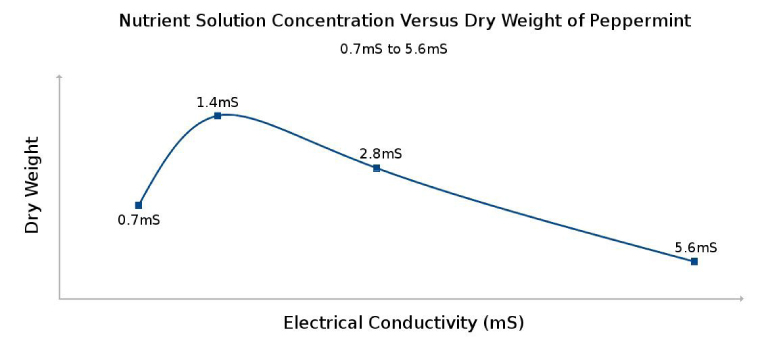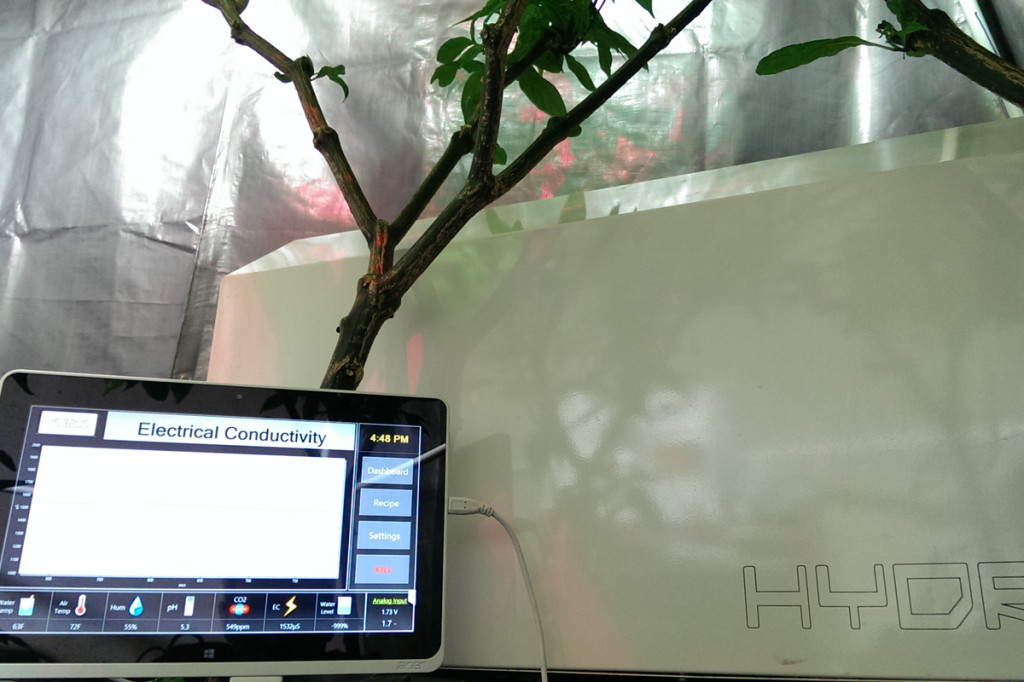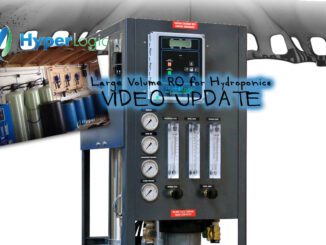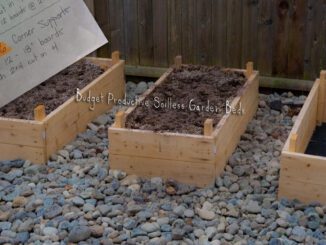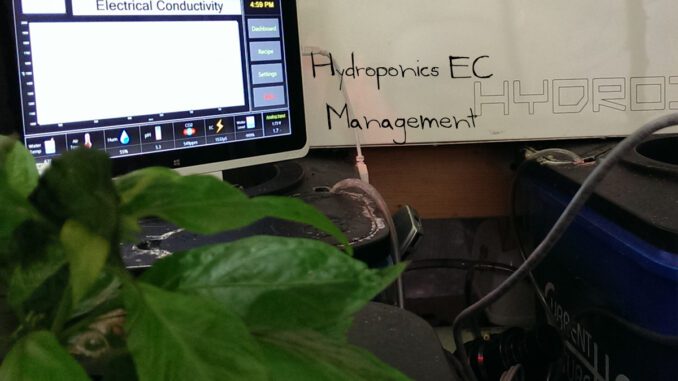
Managing Hydroponic EC Levels
By Jordan Gartenhaus
www.grohaus-automation.com
A novice hobby-horticulturist over watering a plant for the first time is a bit like a new cook learning that more spice doesn’t necessarily make a dish tastier. It’s even more true when it comes to managing hydroponic EC levels.
There comes a point where adding more of ‘something’ actually becomes detrimental to the end product. The same can be said for adjusting the nutrient solution strength of your hydroponic system: Any more than “enough” is “too much.”
Although it sounds deceptively simple, in practice giving a plant more than it needs can often times be a difficult habit to break.
In the past when I looked to experts for guidance in finding the ideal nutrient concentration for my crop, the majority said that I need to feed my plants as much food as they’ll tolerate without exhibiting signs of any stress.
“Look for signs of tip burn,” they’d say, “and then back your concentration off a tad.”
But is that suggestion actually rooted in science, or does it just sound good?
How does nutrient solution strength affect things like fruit mass, brix content, or essential oil production? Thankfully there have been a number of published studies that examine this very question, and we can use their results in order to better understand what’s really ideal for our plants.
This graph (above) is particularly useful because it clearly illustrates how yield in this particular crop dropped as nutrient solution concentration rises significantly past what’s considered “optimal” for that plant. Giving a plant more nutrients than it really needs can absolutely reduce it’s yield, even if the plant isn’t exhibiting signs of stress yet.
That graph actually comes from a study where researchers investigated how hydroponic nutrient solution strength affected growth and essential oil production in peppermint plants (Tabatabaie et al.).
You can see any deviation from the ideal nutrient solution strength of 1.4mS (milliSiemens) resulted in a loss of yield.
1mS = 1 EC = 700ppm (using the 442 conversion factor, which is on most TDS meters commonly used for hydroponics in North America)
Essential oil production at 1.4 mSwas 63% higher than it was at 5.6 mS according to the research cited in this article.
Clearly, an example of how severe over applications of fertilizers are not only harmful to the environment and wasteful-they have proven to decrease your crop’s productivity.
Interesting to note is that although growing the plants in 0.7 mS nutrient solution resulted in mineral deficiencies, they still yielded more than plants growing in the most concentrated nutrient solution (1000 PPM versus near 4000 PPM) in common growing conditions.
So in practical terms, what are these results really telling us?
- The crop has a target or “optimal” EC or Fertilizer Concentration (discussed in mS ) for yields that is dependent on a number of factors. Yield potential declined declined the most leading up to this value. Drastic differences in harvest weights occurred within a steep climb of 0.7mS difference in concentration. That means from increasing nutes from around 650 ppm to 1250 ppm had the biggest impact on yield weight.
- On the way down the hill of yields in the chart, the nutrient concentration is rising. While the difference is more gradual versus not having enough nutrients, it clearly impacts yields in the negative when over applications of fertilizers become compounded over time. Harvest weights suffered the most after the crop began to receive past 2000 ppm versus not supplying enough fertility. More is clearly not always better when it comes to crop fertilizer applications.
Another paper where researchers studied tomato growth in a hydroponic system with varying nutrient solution strengths between 1mS and 9mS (Shwartz & Kuchenbuch).
The researchers were specifically looking to determine the relationship between nutrient solution salinity and water uptake, but maybe not surprisingly they discovered a strong correlation between EC and plant productivity too. They concluded:
“Tomato growth and yield decreased with increasing EC.”
Or put a different way, plants in the weakest nutrient solution they tested grew with the most vigor, produced the most vegetation, and developed the largest fruits. As nutrient solution salinity went up, plant productivity went down.
Now, that isn’t to say that you should go out to your garden and immediately dilute your nutrient solution. It does however add another data point suggesting that once your nutrient solution is at an optimal concentration, any additional food will be detrimental to the plant, and ultimately its yield.
And just to drive the point home, a paper published by the International Society for Horticultural Science (ISHS)studied nutrient concentration on three different types of lettuce and found that “Fresh weight production of the three lettuce varieties decreased with increasing EC level of the nutrient solution” (Abou-Hadid et al.). So, there’s no shortage of evidence showing that nutrients can be detrimental to growth if applied too heavily.
Of course as with most rules there are exceptions. A study I found published in the Australian Journal of Experimental Agriculture was conducted to see if intentionally inducing salt stress in tomatoes could improve the total soluble solids (basically total sugar content, as measured on the Brix scale) (Cornish). As expected, higher EC levels did inhibit yield to some degree, but they found a 1.5x increase in Brix by raising the nutrient solution salinity from 1.5-9.0mS. I found another similar study that came to more or less the same conclusion (Sato). So, if you have everything in your grow room dialled in nicely, then yes, strategic increases in EC can have particular benefits.
Important to note however, is that both of these studies that found a positive correlation between Brix and nutrient solution salinity used supplemental NaCl (common table salt) to increase the nutrient solution salinity beyond “normal” levels. Simply adding your favorite fertilizer until your nutrient solution reaches 9.0mS would almost certainly kill your plants in a hurry.
So what should we take away from all of this?
-
running stronger nutrient concentrations than is necessary mostly results stunted plant growth
-
excess crop feeding will empty your wallet quicker
-
over applications of fertilizers will potentially increase your fertilizer runoff management requirements
I see a lot of parallels to laundry detergent companies that shamelessly suggest that you should use significantly more soap than is really necessary in practice. I’ve found it’s usually a reasonable starting point to take your plant nutrient manufacturer’s dosing suggestions and cut them in half and see how the plants do and adjust from there.
Important Note
The optimal EC for your crop is influenced by a number of environmental factors like:
lights
strains
grow media
HVAC settings
When you change these or other factors in your growing set-up, you may need to do a little fine tuning of nutrient feeding strengths to find an optimal nutrient solution target (EC) again.
These studies also reinforce the importance of keeping a vigilant eye on the nutrient solution concentration.
They demonstrate that even modest swings in EC (increasing or decreasing) can have measurable affects on plant growth and vigor. Maintaining tight control of the nutrient solution strength is critical in order to get the most out of your plants. Buying the most expensive fertilizer and not actively monitoring what the nutrient solution is doing then you’re essentially negating the benefits of that carefully designed nutrient formulation.
All plants have an optimal environment in which they thrive, and by definition they would grow most successfully when those conditions are consistently maintained. So the next time you’re tempted to splash in a little extra nutes into your reservoir for good measure, keep in mind that more is not always better!
About the Author:
Jordan Gartenhaus is one of those people that always tries to figure out how or why things work the way they do.
To that end he earned a BS in mechanical engineering, but shortly after graduating he realized his time spent in school created more questions about everything around him than answers. In an effort to prevent from overwhelming himself now he focuses just on making gardens as fruitful as is scientifically possible. He spends a lot of his time optimizing grow spaces to make the most of the resources available, and also strongly advocates quality automation systems. He would since he co-owns a company that designs and sells their own automation equipment, but despite the conflict of interest he actually does provide excellent insight into the “how” and “why” of gardening.
References:
Schwarz, D. and Kuchenbuch, R. 1998. WATER UPTAKE BY TOMATO PLANTS GROWN IN CLOSED HYDROPONIC SYSTEMS DEPENDENT ON THE EC-LEVEL. Acta Hort. (ISHS) 458:323-328
Tabatabaie, S.J., Nazari, J., Nazemiyeh, H., Zehtab, S. and Azarmi, F. 2007. INFLUENCE OF VARIOUS ELECTRICAL CONDUCTIVITY LEVELS ON THE GROWTH AND ESSENTIAL OIL CONTENT OF PEPPERMINT (MENTA PIPERITA L.) GROWN IN HYDROPONIC. Acta Hort. (ISHS) 747:197-201
Abou-Hadid, A.F., Abd-Elmoniem, E.M., El-Shinawy, M.Z. and Abou-Elsoud, M. 1996. ELECTRICAL CONDUCTIVITY EFFECT ON GROWTH AND MINERAL COMPOSITION OF LETTUCE PLANTS IN HYDROPONIC SYSTEM. Acta Hort. (ISHS) 434:59-66
Cornish, P.S. 1992. USE OF HIGH ELECTRICAL CONDUCTIVITY NUTRIENT SOLUTION TO IMPROVE THE QUALITY OF SALAD TOMATOES (LYCOPERSICON ESCULENTUM). Australian Journal of Experimental Agriculture 32:513–520.
Sato, S., Sakagushi, S., Furukawa, H., Ikeda, H. 2006. EFFECTS OF NACL APPLICATION TO HYDROPONIC NUTRIENT SOLUTION ON FRUIT CHARACTERISTICS OF TOMATO (LYCOPERSICON ESCULENTUM, MILL.). Scientia Horticulturae. 109:3:248-253

